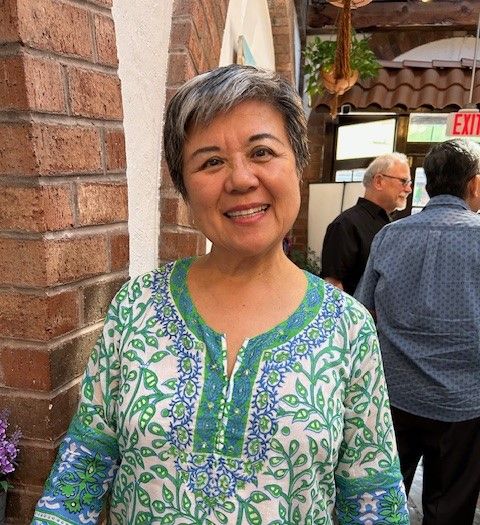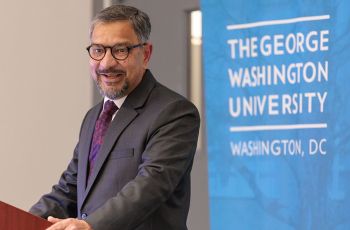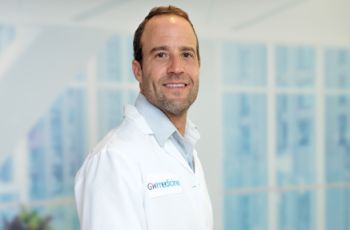When Emily Chiang scheduled her annual mammogram in December 2020, she expected it to be like every other year — quick, routine, and reassuring. For more than two decades, she had faithfully visited the GW Medical Faculty Associates Breast Imaging Center, always leaving with a clean bill of health. But this time would be different.

“I remember feeling impatient that day,” Emily said. “It was right before the holidays, and I had so many things on my mind.”
Rachel Brem, MD, Vice Chair of Radiology and Director of the Breast Imaging and Intervention Center, noticed subtle changes on Emily’s images that concerned her. “She told me she saw something in my left breast that looked different and wanted to do a biopsy right away,” Emily recalled. “I’d worked with Dr. Brem for years and completely trusted her judgment.”
Two biopsies were performed: the first on the day of the mammogram and the second when a second lesion was discovered after the mammogram results. “The procedure was fast and painless, but the wait afterward was agony,” Emily said. “Even though Dr. Brem told me that most biopsies turn out benign, I couldn’t stop thinking about the worst-case scenario.”
A week later, the results confirmed what she feared: two small tumors in her milk ducts. It was ductal carcinoma in situ, or DCIS, stage 0—a noninvasive form of breast cancer that, if left untreated, could become invasive.
“I was completely stunned,” she said. “I had no symptoms at all. I kept asking myself—why me? What caused this? Was it something I did, or was it in my genes?” Yet even in the midst of fear, she found gratitude. “I realized how lucky I was that the cancer was caught so early,” she said. “Dr. Brem’s vigilance probably saved my life.”
As a lifelong Buddhist, Emily has learned to befriend what she calls the beautiful monster — the emotions and fears that arise when life brings challenges. “When you face something frightening, you don’t fight it,” she explained. “You greet it, listen to it, and learn from it.” That was the day, she said, that she met her own beautiful monster. “It was terrifying, but it also forced me to stop, listen, and look inward. The monster wasn’t here to destroy me, it was here to teach me.”
A City in Turmoil, a Moment of Calm
Emily was referred to Christine Teal, MD, Director of the GW Breast Care Center. Her consultation was scheduled for January 7, 2021, just one day after the Capitol riot. “When I drove into D.C. that morning, the streets were eerily quiet,” she said. “There were police and roadblocks everywhere. The city felt shaken.”
But inside the Breast Care Center, calm prevailed. “Despite everything happening outside, Dr. Teal was cheerful, composed, and completely focused,” Emily remembered. “Her confidence was contagious.”
Dr. Teal explained the diagnosis and recommended a breast-conserving lumpectomy, followed by radiation therapy. “She told me that because my cancer was caught so early, my prognosis was excellent,” Emily said. “That gave me hope.”
Because of COVID-19 restrictions, Emily had to go into the hospital alone for surgery. “That was one of the hardest parts,” she said. “No family members were allowed to be with me. I had to rely on faith and trust.”
Before surgery, a seed localization procedure was performed, in which tiny radioactive metal markers, about the size of a sesame seed, were placed in the abnormal breast tissue to guide Dr. Teal during the operation. “When I was lying on the table before surgery, I told Dr. Teal, ‘I’m scared,’” Emily recalled. “She smiled and said, ‘Don’t be scared.’ It sounds simple, but those three words gave me incredible peace.”
The surgery went smoothly, and Emily returned home the same day.
The Next Chapter: Radiation
Two weeks later, Emily met with Sharad Goyal, MD, Director of the GW Radiation Oncology Program, to plan the next stage of her treatment. “Dr. Goyal explained everything so clearly,” she said. “He reassured me that DCIS was highly treatable and that radiation would reduce my risk of recurrence.”
He also told her something she never forgot: “If you have to have cancer, this is the best kind to have.”
“I needed to hear that,” Emily said. “It gave me perspective and strength.”
Emily began a four-week course of daily radiation, 20 sessions in total. “I didn’t want to go through it,” she admitted. “But Dr. Goyal’s advice was clear: ‘Fight, don’t flight.’ So I chose to fight.”
The first two weeks went smoothly, but by the third, fatigue set in. “Radiation has a cumulative effect,” she explained. “I was so tired I could barely walk from the parking lot to the clinic. My skin became tender, and my energy vanished.” Still, Emily showed up every day. “Dr. Goyal’s team was extraordinary,” she said. “They treated me not just as a patient but as a person. They were gentle, compassionate, and kind. You could tell they saw their work as a calling.”
On the final day, the staff surprised her with cheers and applause. “They said, ‘Congratulations, Emily, you’ve graduated!’ I burst into tears. Their support meant everything.”
A Journey of Acceptance
As the weeks passed, Emily found herself changing, not just physically, but emotionally and spiritually. “At first, I was just trying to survive,” she said. “But over time, I realized this was a lesson in patience and faith.”
She began meditating before each session, repeating a quiet mantra of gratitude. “It became a kind of spiritual training,” she said. “I felt like Alice in Wonderland, falling into a new world where everything looked different, but somehow, I was learning to trust it.”
By the end of radiation, Emily no longer felt like a victim. “I felt like a student,” she said. “The experience was teaching me to slow down, to surrender, and to find joy in the smallest things.”
The beautiful monster she had feared at the beginning had transformed into a teacher. “It showed me my own strength,” she said. “It forced me to confront fear. And then let it go.”
Guidance and Humor
After completing radiation, Emily began follow-up care with oncologist Robert Siegel, MD, at the GW Cancer Center. “He was warm, funny, and very experienced,” she said. “He told me I was lucky my cancer was caught early and prescribed Tamoxifen for five years to prevent recurrence.”
But what she remembers most from that first appointment wasn’t the medication, it was his advice. “I asked whether I had a high chance of dying from breast cancer,” she said. “He didn’t like that question. He looked me straight in the eye and said, ‘Emily, don’t talk about dying. Just keep living. I have to say a prayer every day just to cross Pennsylvania Avenue!’”
They laughed together, and that moment shifted everything for Emily. She was reminded that life is meant to be lived, not feared.
Lessons in Compassion
Through her journey, Emily found a renewed faith in people. “Every doctor, nurse, and technician I met showed me extraordinary kindness,” she said. “They became my guardian angels.”
The experience also deepened her empathy. “Before this, I didn’t fully understand what sick people go through,” she said. “Now I do. I’m more compassionate, more patient, and more aware of how fragile life really is.”
Still, there were difficult moments. Her brother was diagnosed with stage 4 bone cancer while she was in treatment and passed away during her last week of radiation, leaving Emily heartbroken. She also chose not to share her diagnosis widely at first. “I was too overwhelmed,” she said. “I didn’t want to deal with other people’s reactions while I was trying to stay strong.” When she eventually opened up, some friends offered prayer and empathy, while others said things that were unintentionally hurtful.
“I learned that not everyone knows what to say,” she said. “But I also learned to speak up about what I need.” Krystin Harper, the Patient Advocacy Director at the GW Breast Care Center, helped Emily navigate those emotions and encouraged her to build a loving network and avoid negativity. Emily calls that “some of the best advice I’ve ever received.”
Embracing Change
Months after surgery, Emily began rebuilding her strength. “Radiation made me tired and weak,” she said. “But step by step, I started walking and swimming again.”
She also had to make peace with her body. “The first time I saw my scar, I cried,” she said. “It was a reminder of everything I’d been through.” Over time, though, she came to see her scar as a symbol of strength and survival.
Her Buddhist faith helped her embrace this perspective. “In Buddhism, we learn that life is impermanent,” she said. “Our bodies change, our circumstances change. But peace comes from accepting that.”
A New Sense of Purpose
Now cancer-free, Emily feels called to share her story. “When I tell women about my experience, they listen,” she said. “Many realize they’ve been putting off their mammograms and schedule them right away.”
After hearing Emily’s story, several friends scheduled screenings. One younger friend — just 43 — discovered a small growth during her first mammogram. It turned out to be benign, but Emily knows it could have been worse. “She told me, ‘Because of you, I went,’” Emily said. “That’s when I realized that sharing my story can save lives. If my journey can help someone else face their diagnosis with peace and courage, that’s the greatest reward.”
Lessons Learned
Emily often describes her diagnosis as her teacher. Through fear and healing, she discovered a new way of living with presence, gratitude, and intention.
She shares these takeaways with anyone facing a similar path:
- Get your mammogram on time. Early detection saves lives.
- Accept your treatment. Go with the flow and trust your care team.
- Care for your body. Eat nourishing food, rest, and move gently as you heal.
- Be patient with yourself. Recovery isn’t linear; give yourself grace.
- Find your people. Build a circle of positivity and support.
- Don’t be afraid to talk about it. Sharing your story can give others strength.
- Reflect on your legacy. Focus on what truly matters: kindness, love, and purpose.
Living with Gratitude
Today, Emily continues her follow-up appointments at the GW Cancer Center. Her mammograms remain clear, and her energy has returned. “I don’t take anything for granted anymore,” she said. “Every sunrise, every meal with my husband, every laugh with a friend…these are gifts.”
She remains deeply grateful to her care team: Dr. Brem, Dr. Teal, Dr. Goyal, Dr. Siegel, and every nurse, technician, and therapist who walked beside her. “They weren’t just medical professionals,” she said. “They were healers. They cared for my soul as much as my body.”
Emily’s story is one of courage and renewal. What began as a frightening diagnosis became a journey of peace, faith, and rediscovery. “The beautiful monster changed my life,” she said. “It taught me that I am stronger, braver, and more compassionate than I ever imagined. I choose to live fearlessly. And to focus on what truly matters.”



